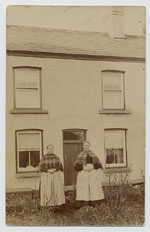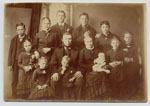|


Poor living conditions undermined the health of women and children. Poverty and unemployment affected their health through the lack of adequate diet and clothing. It was not uncommon for women to go without food so that they could provide enough for their husbands and children, thus damaging their own health or in extreme cases dying of starvation. Housing that was overcrowded, insanitary, and damp added to the health problems of families. Women bore the burden of daily housekeeping and cleaning, and were often exhausted and overworked by preparing baths and meals for the working-men in the family, as well as constant washing and drying of work-clothing. The introduction of pit-head baths at some collieries partly resolved these problems, as the men could bathe before they went home, and could leave behind their work-clothes to dry.
Women who were pregnant, or had young or school-age children, bore additional burdens of responsibility and risks to their health. The Rhondda MOH reports of 1914 to 1947 provided details relating to the district Maternity and Child Welfare Schemes, and statistics relating to births and deaths, puerperal fever, nutrition, and midwives. Rhondda Urban District Council was one of a few authorities which had distributed milk to malnourished mothers since 1919, and provided additional food during the 1926 General Strike. The National Birthday Trust Fund, set up in 1928, provided maternity services for ‘Special Areas’. These were areas where food was distributed to impoverished pregnant women. In 1933, a scheme was initiated in the Rhondda Valley by Lady Williams of Miskin Manor, whereby two District Sister-Superintendents from London worked as Assistant Inspectors of Midwives in the area. There was an increase in ante-natal care, and refresher courses for local midwives. Llwynypia Hospital provided emergency care, and an obstetric consultant was appointed. The scheme was supplemented in the 1930s by the distribution of food to combat malnutrition. Maternity and Child Welfare Centres were helping to supervise expectant mothers, and provide milk and medicinal foods. Mothers attending Welfare Centres were entitled to vouchers covering their travel expenses. During the 1940s the District Council was providing dried milk and cod liver oil for children and expectant mothers, and at the Glyncornel Maternity Home, vitamin supplements and fruit juice were also available. In 1944, home helps were part of the Maternity and Child Welfare Service.
School medical inspections regularly took place, with the emphases placed on hygiene, physical exercise, sanitation, and nutrition. Statistics were provided relating to diseases and defects, uncleanliness, ringworm, teeth, tonsils and adenoids, ears and hearing, eyes and vision, tuberculosis, height and weight, and so-called 'defective' children. Diseases such as diphtheria and scarlet fever were prevalent, and outbreaks occurred, for example, in 1932 in Treorchy and Maerdy (diphtheria), and in Gelli (scarlet fever). Immunisation against diphtheria was underway in the Rhondda in 1940. Also in 1940, the School Medical Officer reported on ‘Scabies and other contagious skin affections’, and also ‘Crippling Defects and Orthopaedics’. During the Second World War, nurseries were set up, and the Government Evacuation Scheme for school children took place. There was an influx of evacuees into south Wales, and healthcare provisions were set in place, for example an emergency sick bay for evacuees was arranged at Penrhys Smallpox Hospital, for contagious skin diseases.
Further Reading
Reports of the Medical Officer of Health, and School Medical Officer, Rhondda Urban District
Council, 1914 – 1947
Williams, A. Susan, Women and Childbirth in the Twentieth Century: A History of the National Birthday Trust Fund
1928-93, (Stroud: Sutton Publishing, 1997)
|
|








